
An Experiment in Arboriculture and Mosquito Control
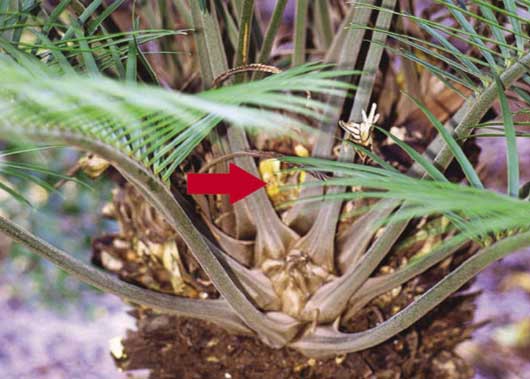
Story and photos by Jeff Shimonski, Director of Horticulture, Jungle Island, Miami, Florida
Reprinted from:
Republished from CityTrees, the Journal of the Society of Municipal Arborists.
March / April 2009
There are approximately 3000 species of mosquito in the world, about 200 in theUnited States and about 60 species are found where I work in Miami-Dade County, Florida. Many of these mosquito species are not only annoying biters of humans or animals but are also disease vectors. Mosquito abatement for public health should be part of the urban forester’s scope of practice.
My IPM work at Jungle Island, an 18-acre zoological theme park in Miami, Florida, has included control of mosquitoes via biorational larvicides instead of broadcasting pesticides as a fog or spray to blanket large areas, which can harm beneficial insects and other organisms. I’ve investigated controlling populations of mosquitoes via scouting, species identification, and application of biologically benign larvicides that only harm mosquitoes. Through an EPA Pesticide Environmental Stewardship Program-sponsored study that began in 2005 and continues today, I was able to design, install, grow, and maintain an entire landscape sustainably, without commercial fertilizers or pesticides.
All mosquitoes breed in water. Depending on the species, the female may lay her eggs directly on the water; the eggs will float upon the surface until hatching. Certain species lay their eggs above the water, along the sides of a container or tree hole, or on a damp substrate. The eggs laid above the water may dry out and remain viable for months or even years before they hatch when they become inundated.
Once the eggs hatch, there are four larval stages. These are the “wigglers” that you see in the water. The fourth instar larva turns into a pupa for a short period of time, and soon after, the adult emerges from the water. Not all mosquito species select the same type of watery habitat to lay their eggs—some species prefer clean water, while others prefer water high in organic matter.
On every continent, from moving streams to abandoned car tires and tree holes, mosquitoes have evolved to utilize many different types of larval habitats.
Some of the mosquito species that will breed in tree holes and some of the diseases that they may vector:
• Aedes albopictus is found worldwide and vectors dengue, West Nile virus (WNV), and Chikungunya (viral illness that resembles dengue).
• Aedes aegypti is found worldwide and vectors yellow fever, WNV, and dengue.• Aedes sierrensis is found in the western U.S. and vectors dog heartworm.
• Aedes triseriatus is commonly called the eastern tree-hole mosquito (occurring in eastern and central North America) and vectors eastern equine, LaCrosse encephalitis, and WNV.
• Anopheles species are worldwide vectors of human malaria, numerous animal pathogens, and WNV.
• Culex quinquefasciatus is a worldwide opportunistic tree-hole mosquito that vectors WNV, avian malaria, Wuchereria bancrofti, Western equine encephalomyelitis, and St. Louis encephalitis, and has been implicated as a vector of dog heartworm.
As they mature, trees often develop tree holes or cavities that will hold water. Poor pruning practices damage trees and greatly increase the incidence of rotten cavities. The damage from radical hurricane pruning is especially evident here in South Florida. Many of the tree holes where I find mosquito larvae are cavities that resulted from hurricanes and the subsequent pruning.
During mosquito larvae sampling on tree holes that contained as little as a few ounces of water, I have identified larvae of mosquito species with the potential to be aggressive biters and vectors of serious disease. To combat these, I tested a number of biorational chemicals, including Bacillus thuringiensis israelensis, Bacillus sphaericus, the insect growth regulator methoprene, and two monomolecular films, with mostly good results. But since tree holes can be high above the ground, it can be physically difficult and very time consuming to scout tree holes every three to four weeks and apply a larvicide if needed.
How to more creatively address the problem? Drilling into tree holes or cavities for drainage will expose living wood to further damage. Filling tree holes with concrete or other substrates is no longer encouraged and has never been shown to add strength to the tree or reduce decay. Installing some kind of deflector to prevent the entry of water into the tree holes is difficult and not practical. Since there is a great need to exclude these potentially harmful mosquitoes from breeding sites, I looked for a way to fill these holes in a manner that would cause minimal or no damage to the tree, be fairly easy to apply, and be cost efficient.
To exclude mosquitoes from tree holes, I began to spray utility foam into these cavities. The foam seems to hold up very well here in South Florida, even when exposed to sunlight and weather. Some brands of foam can be applied when the hole is wet; however, in my experience it is best to dry out the cavity first and remove any detritus. If the foam expands too much it can be cut off and even painted.
Will the foam harm the tree in the long term? I can’t imagine the foam abrading the wood inside the cavity because of tree movement, because the tree holes that I have worked with are usually in very stable (stationary) parts of the tree—e.g., the main trunk or in scaffold branches. And the alternative—holes left to hold water—results in damage and rot.
The use of foam to fill tree holes is not an uncommon practice. In the course of researching the possibility of using foam in tree cavities, I spoke with Stella Cuestas, the curator of cycads at the Montgomery Botanical Center (MBC) in Coral Gables, Florida. MBC is a 120- acre garden established in 1959 that maintains a very large collection of palms and cycads. Stella told me that foam has been successfully used to fill damage or decay holes in the trunks of their cycads for many years. The trunk of a cycad is not as durable as the woody trunk of a typical tree. With cycads, before filling a hole with foam, the cavity is cleaned out and all soft dead or dying tissue adjacent to the cavity is removed. A fungicide may then be applied inside the cavity. Once dry, the foam is applied. Many of the cycads at the MBC that have been treated have produced new growth within a year or two. One of the photos in this article shows a cavity that was filled eight years ago on a large, very old male palma corcho (Microcycas calocoma).
Worldwide, mosquito control is an important public health service to residents of our urban forests. Techniques such as foam filling can result in less pesticide use while effectively removing mosquito larval habitats.
Photo Gallery
Click Photos to Enlarge
 The arrow indicates where foam had been sprayed into a large cavity on the trunk of
this cycad (Lepidozamia peroffskyana) at Montgomery Botanical Center. All of the foliage,
which is covering most of the visible foam, is new since the application over a year ago.
The arrow indicates where foam had been sprayed into a large cavity on the trunk of
this cycad (Lepidozamia peroffskyana) at Montgomery Botanical Center. All of the foliage,
which is covering most of the visible foam, is new since the application over a year ago.
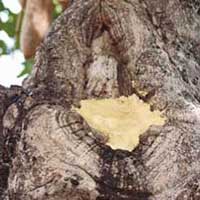 A sausage tree (Kigelia africana) with a foam-filled
tree hole at Jungle Island. This cavity, monitored for
three years before foam was applied, had Aedes
aegypti larvae inside.
A sausage tree (Kigelia africana) with a foam-filled
tree hole at Jungle Island. This cavity, monitored for
three years before foam was applied, had Aedes
aegypti larvae inside.
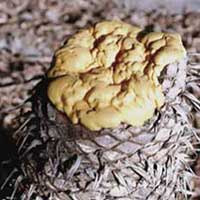 A trunk of the cycad Cycas hongheensis at Montgomery
Botanical Center had a rotten cavity that was cleaned out and filled with foam.
A trunk of the cycad Cycas hongheensis at Montgomery
Botanical Center had a rotten cavity that was cleaned out and filled with foam.


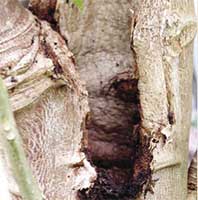
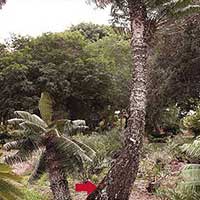
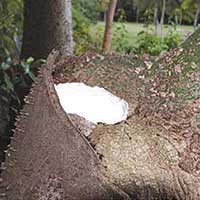
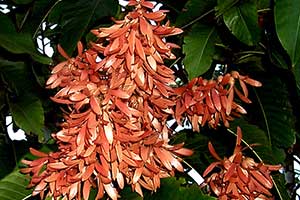 About Tropical Trees & Arboriculture
About Tropical Trees & Arboriculture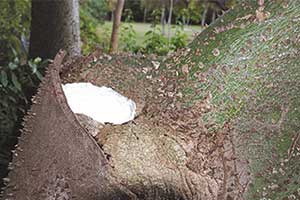 An Experiment in Arboriculture and Mosquito Control
An Experiment in Arboriculture and Mosquito Control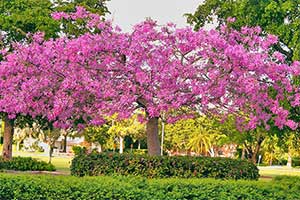 Ceiba Speciosa
Ceiba Speciosa Why Trees Blow Over
Why Trees Blow Over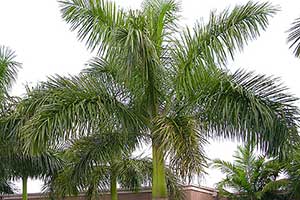 Royal Palm Bugs
Royal Palm Bugs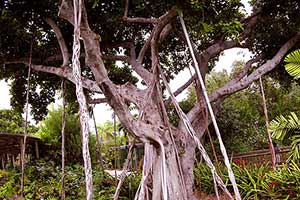 Ficus Species & Hurricane Horticulture
Ficus Species & Hurricane Horticulture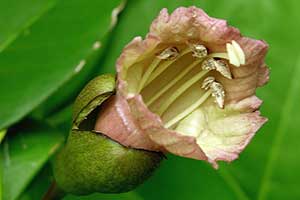 Pollination and the Natural History of the Calabash Tree
Pollination and the Natural History of the Calabash Tree Pollinating Sausage Trees
Pollinating Sausage Trees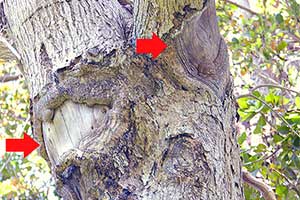 Some Observations on Relocating Tropical Trees
Some Observations on Relocating Tropical Trees